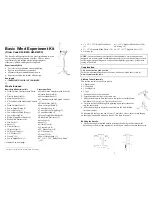
3
2. Fit the nacelle onto the
plastic
tower and secure it with an additional two screws.
3. Thread hex nuts about 2/3 of the way up the 4" bolts. Next, slide the two motor
mount sections up the bolts such that the two concave sections are facing each
other. Then thread another hex nut onto each bolt under the mounts. Do not
tighten the motor mount sections together.
4. Slide the motor mount assembly into the cutouts by angling them in from the
side. See the illustrations below.
5. Once both bolts are in place on the nacelle, thread the wing nuts onto the bottom
of each bolt and tighten. Be careful not to over-tighten the wing nuts on the
bottom of the nacelle, or you will bend the nacelle. Over tightening may not break
anything, but can make your turbine less efficient.
The wing nuts and hex nuts may be used interchangeably in constructing the motor
mount. While wing nuts are easier to adjust, the smaller size of the hex nuts allows
for more vertical range.
Generator and Gears
1. Place the Wind Turbine Generator in the motor mount,
with the wires close to the tower. Then tighten the nuts to
hold the generator securely in place. Attach the wires to
the
plastic
tower with zip-ties or tape
.
Optional: If you are using a
PVC
tower, you can snake the
wires from the motor through the slot in the nacelle behind
the motor mount. Then the wires can go down through the
PVC
pipe. On a wood tower, the wires can go out the side
of the nacelle.
2.
Attach the smallest gear (pinion) to the drive shaft of the
generator. The small hole in this gear should slide onto the
generator drive shaft and the pinion will be held on by
friction.
3. Slide the hex shaft with attached Hub Quick Connect
into the hole at the top of the nacelle. You may need
to wiggle or rotate the hex shaft as you push it in.
Slip a hex lock onto the hex shaft with the collar
facing the nacelle.
4
4. Attach the 32-tooth gear onto the hex lock. Move the generator up or down so
that the pinion gear meshes with the gear on the hex shaft.
Add Turbine Blades
Assemble blades by gluing dowels onto blade materials cut
into shape if desired. You can also shape the blades after
assembly. We recommend hot glue for quick assembly, but
classroom white glue or wood glue will also work if you have
time to allow for drying.
Loosen the Wind Turbine Hub and insert blades
symmetrically around the hub. Before the blades are held
tightly, angle the blades as desired. Tighten the hub to lock the
blades in place.
The Hub Quick Connect (HQC) allows for easy removal and attachment of the hub.
This enables users in busy classroom environments to change blade configurations
quickly and easily. If you wish to secure the Wind Turbine Hub onto the HQC, use
the set screw provided.
Strong wind, large or out of balance turbine blades, and wear can make the HQC
unstable.
Caution:
The hub is designed to have a very tight fit to the Quick Connect, but if
your blades are unbalanced or your turbine is not directly facing the wind, it may
come loose. Be careful with blades that are out of balance.
Measuring Turbine Output
Your turbine is converting wind energy to electrical energy, in some amount. There
are several ways to get an idea of how much energy the turbine is generating.
LED
Connect the positive terminal wire of the generator to the longer lead of the LED and
connect the negative terminal wire to the shorter lead of the LED. The brightness of
the LED is a general indicator of how much energy is being generated.
KidWind Power Output Board
Connect the positive and negative terminal wires of the generator to the visual
voltmeter terminals on the KidWind Power Output Board (KW-POBD) using
alligator clip leads. Reverse the wires if the “reverse polarity” LED lights. The visual
voltmeter lights an additional LED for each additional half-volt of electric potential.
The energy being produced is proportional to the voltage.
Vernier Energy Sensor
Connect the positive terminal wire of the generator to the red terminal of the Vernier
Energy Sensor (VES-BTA) and connect the negative terminal wire to the black
terminal of the Energy Sensor. Connect a load such as a resistor or the Vernier
Variable Load (VES-VL) to the Load terminals of the Energy Sensor. Connect the
Energy Sensor to an interface and use either LabQuest or Logger
Pro
to see readings
of current, voltage, power, and resistance. Energy is the product of power and time if
power is constant, so you can use the power reading as an indication of electrical
energy production.




